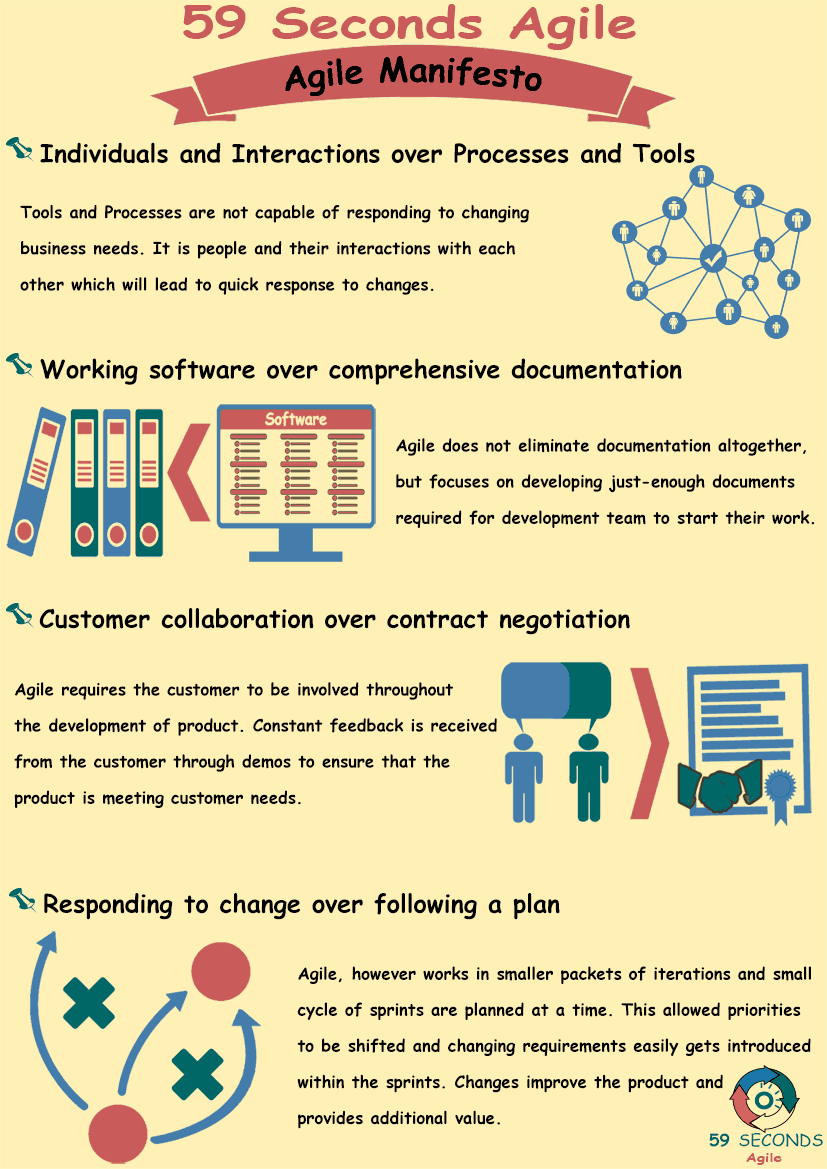Using the Agile Manifesto to Deliver Change
A 59 Seconds Agile Training Video
Continue to Part 7 Below
The Agile Manifesto
A 59 Seconds Agile Article
This article provides an ‘Introduction to the Agile Manifesto’ and looks to discuss what a values are stated within the Manifesto.
Customer Collaboration over Contract Negotiation
Prioritizing customer collaboration instead of contract negotiation improves the entire process, and creates a much more adaptable development environment. Negotiating a contract is an intense, stressful process for all parties involved. Customers are seeking to maximize the value of the finished product, while minimizing costs and time before they receive the software.
Representatives of the product company are looking to address all points of uncertainty. Plus, they must minimize the risk that a company faces between creating a piece of software and receiving payment.
The Product Owner, the development team, and the Stakeholders will all learn more about what the finished product will look like as the process progresses. However, a contract forces them to make a judgment call at the very beginning when uncertainty is high. The Agile Manifesto allows this process to occur over the life of a project, rather than forcing Stakeholders to decide at the very beginning.
Any contract covers only the most essential concepts. This allows most of the product terms to be decided as development continues. Over time, stakeholders can adjust their requests for the product based on their experience with earlier iterations. This reduces risk, and allows all roles to work together for the common goal of a working product that is satisfactory for the customer.
The Agile Manifesto is a declaration of guiding software development principles with the goal of delivering value early in an iterative fashion. The agile manifesto is stated as follows:
“We are uncovering better ways of developing software by doing it and helping others to do it. Through this work, we have come to Value:
Individuals and interactions over processes and tools
Working software over comprehensive documentation
Customer collaboration over contract negotiations
Responding to change over following a plan
That is, while there is Value in the items on the right, we Value the items on the left more.”
©Agile Manifesto Copyright 2001: Kent Beck, Mike Beedle, Arie van Bennekum, Alistair Cockburn, Ward Cunningham, Martin Fowler, James Grenning, Jim Highsmith, Andrew Hunt, Ron Jeffries, Jon Kern, Brian Marick, Robert C. Martin, Steve Mellor, Ken Schwaber, Jeff Sutherland, Dave Thomas. This declaration may be freely copied in any form, but only in its entirety through this notice.
Continue Reading —> Next
The Agile Manifesto
A 59 Seconds Agile Video Animation
Continue Reading —> Next
User Stories Applied
A 59 Seconds Agile Book Review
User Stories Applied by Mike Cohn is one of our favourite books on Agile User Stories. The book starts with an overview into user stories, and details what a user story is and the different aspects of them. He then discusses how to go about writing a user story, and provides details of the INVEST criteria that can be used to determine if the story is meeting all of its objectives. Next Mike gives an in depth discussion of who user stories are written for and where to begin when gathering the details for them. The book then discusses acceptance testing user stories, including how to go about specifying these criteria and the responsibilities of the development team and customers during this process.
Continue Reading —> Next
The Agile Manifesto
A 59 Seconds Agile Infographic

Continue Reading —> Next
Agile Scrum Master Training Course
Our Favourite Agile Books
We found these books great for finding out more information on Agile Scrum:
Continue Reading —> Next

